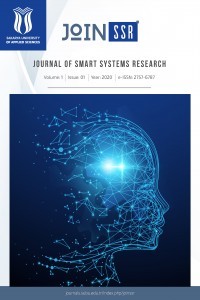Real-Time Arrhythmia Detection Using NI LabVIEW and Sending Notification via SIM800L GSM Module
Real-Time Arrhythmia Detection Using NI LabVIEW and Sending Notification via SIM800L GSM Module
Electrocardiogram (ECG), Arrhythmia, ArduinoUNO, SIM800L,
___
- [1] W. H. Federation, Global Atlas on Cardiovascular disease prevention and control, 2011.
- [2] T. Padma, M. M. Latha and A. Ahmed, "ECG comparison and labview implementation.," Journal of Biomedical Science and Engineering, vol. 2, no. 3, pp. 177-183, 2009.
- [3] I. A. AL-QARAGHULI, Labview based simulation and automatic analysis of ECG signals using FPGA, University of turkish aeronaurical association, 2017.
- [4] M. Muruggapan, R. Thirumani, M. I. Omar and S. Murugappan, "Development of cost effective ECG data Acquisiton system for clinical applications," in IEEE 10th International Colloquium on Signal Processing& its Applications (CSPA2014), 2014.
- [5] S. N. Ilker, Ekg sinyalleri için aritmi sezimi ve mobil ağlar üzerinden iletim., İstanbul: Istanbul University, 2018.
- [6] P. Kanani and M. Padole, "Recognizing Real Time ECG Anomalies Using Arduino, AD8232 and Java," in International Conference on Advances in Computing and Data Sciences, Singapore, 2018.
- [7] A. R. Satani, D. R. Damodar and B. R. Satani, "Heart arrhythmia detection using labview GUI based approach," International Journal of Advanced Technology and Engineering Exploration, vol. 5, no. 48, 2018.
- [8] N. Ahmed and Y. Zhu, "Early Detection of Atrial Fibrillation Based on ECG Signals," Bioengineering, vol. 7, no. 1, p. 16, 2020.
- [9] S. Rege, T. Barkey and M. Lowenstern, "Heart arrhythmia detection," in 2015 IEEE Virtual Conference on Applications of Commercial Sensors (VCACS), Raleigh, NC, USA, 2015.
- [10] S. Das, S. Pal and M. Mitra, "Arduino-based noise robust online heart-rate detection," JOURNAL OF MEDICAL ENGINEERING & TECHNOLOG, vol. 41, no. 3, pp. 170-178, 2017.
- [11] "Guide U.," National Instruments myDAQ, 2016.
- [12] A. N. Ay, M. Z. Yildiz and B. Boru, "NI Labview kullanılarak EKG Sinyallerinin Gerçek Zamanlı Özellik Çıkarımı," SAU Fen Bilimleri Enstitüsü Dergisi, 2017.
- [13] S. Butterworth, "On the Theory of Filter Amplifiers," Experimental Wireless& the wireless Engineer, vol. 7, pp. 536-541, 1930.
- [14] F. Holmqvist, P. G. Platonov, R. Havmöller and J. Carlson, "Signal-average P wave analysis for delineation of interatrial conduction-Further validation of the method," BMC Cardiovascular Disorders, 2007.
- [15] H. Beyramienanlou and N. Lotfivand, "An Efficient Teager Energy Operator-Based Automated QRS," Journal of Healthcare Engineering, vol. 11, 2018.
- [16] A. N. Ay, B. Dolukan and M. Z. Yildiz, "The Effect of Attentional Focus Conditions on Performer's EMG Activity," Academic Perspective Procedia, vol. 1, no. 1, pp. 240-247, 2018.
- Başlangıç: 2020
- Yayıncı: Sakarya Uygulamalı Bilimler Üniversitesi
Real-Time Arrhythmia Detection Using NI LabVIEW and Sending Notification via SIM800L GSM Module
Ayşe Nur AY, Esat Egemen YUKSEL, Akın Yiğit YILMAZ, Yaşar Barış DOLUKAN
EMG Tabanlı İnsan Robot Etkileşimi
Beyin Sinyalleri Kullanılarak Elde Edilen Dikkat Değeri ile Araç Yönetimi
Investigation of Chaoticity of Vibrations in Machining
